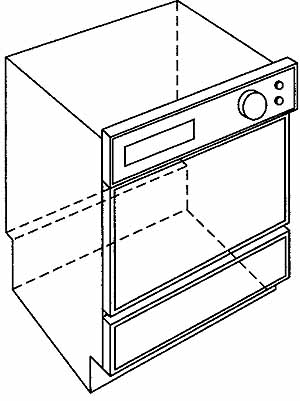Selecting, purchasing, and installing Dishwashers
| HOME | Troubleshooting | DIY Tips |
|
During the past decades, dishwashers have proven their value and usefulness in reducing the cleanup tasks in the kitchen. They not only save time, energy, and labor, but they also deliver dishes cleaner than those washed by hand. The most common type is the built-in dishwasher. However, there are other styles available for special situations. When selecting a new dishwasher ( Fig. __11), there are some questions to consider: • Is it a front-loading undercounter model? Portables are less convenient because they must be moved into position and hooked to a faucet every time they are used. • Does it have front controls? • Does it have a self-cleaning filter, rather than one that has to be removed and cleaned? • Does it have dispensers and silverware baskets in an easy-to-reach location? • Are the silverware baskets on the door, or in the bottom rack? • Are the racks designed with flexibility for easy loading of tall or bulky dishes?
Built-in models Built-in models are designed to fit into a 24-wide space between two kitchen cabinets, and under the countertop. Also available are smaller capacity models that fit into an 18” space. Convertible/portable models Convertible/portable models are essentially the same as built-ins, but they have finished sides and tops, drain and fill hoses with a faucet connector, and casters for easy rolling to the sink. These can be installed later as built-ins, if desired. Undersink model An undersink model is designed to fit under a special 6-inch deep sink in just 24 inches of space; or under a special double-bowl sink, with a disposer under the second bowl, in 36 inches of space. These dishwashers were designed for small kitchens with limited cabinet space for storage. Dishwasher-sink combination A dishwasher-sink combination unit is also available. It includes a stainless steel sink with drainboard, an enameled metal undersink cabinet, and a dishwasher in 48 inches of space. Some “Pullman-type” combination units include a dishwasher as well as a sink, range, and/or, in some, a refrigerator; all in one unit. Listed below are some advantages and disadvantages of dishwashers: Advantages • Can save the physical labor of washing dishes. • Provide out-of-the-way storage for dirty or clean dishes. Disadvantages • Require an 18-inch or 24-inch space in the kitchen, so a cabinet might have to be removed. • Are nearly always designed for use with standard 36-inch high countertops. This might require a two-level counter, if the sink is installed at a 30-inch height for a wheelchair bound person. Checklist for dishwashers Before going to the store for selecting and purchasing, ensure that this section on dishwashers has been read and filled out. Check all that apply: Model
• Loading convenience
• Wash system
• Control panel
• Cycles
• Finishes Tub ___________ Racks________ Color panels Trim kits_________________ Preferred color________________ • Price range: $_________________ • Warranty and service information:_____
Prev: Freezers |
 __11. The undercounter dishwasher is available in 18- or 24-inch
width. Portable models are also available.
__11. The undercounter dishwasher is available in 18- or 24-inch
width. Portable models are also available.